In the field of digital technologies and data there are some conferences in Europe worth seeing. On top of that, there are a few that you can feel really be sorry if missing them. Well, and at the top of this imaginary pyramid of know-how, there is a very short list of those conferences from which you will have goosebumps still several weeks after their closing. One such conference is the NOAH conference in Berlin, which I had the honor of attending few weeks ago. More than 500 speakers (yes, reading right) in 2 days for more than 4000 people in the audience (yes, reading it correctly again) will prepare a hailstorm that you would seek to recover from longer than over evening after-party. The conference is known to leave the presenters only 6-10 minutes, so you can hear 20 – 30 unique approaches of dealing with issues in a single 3-hour block. Pure massacre. I guess that after day one you wished you would have been rather landscaping all day long.
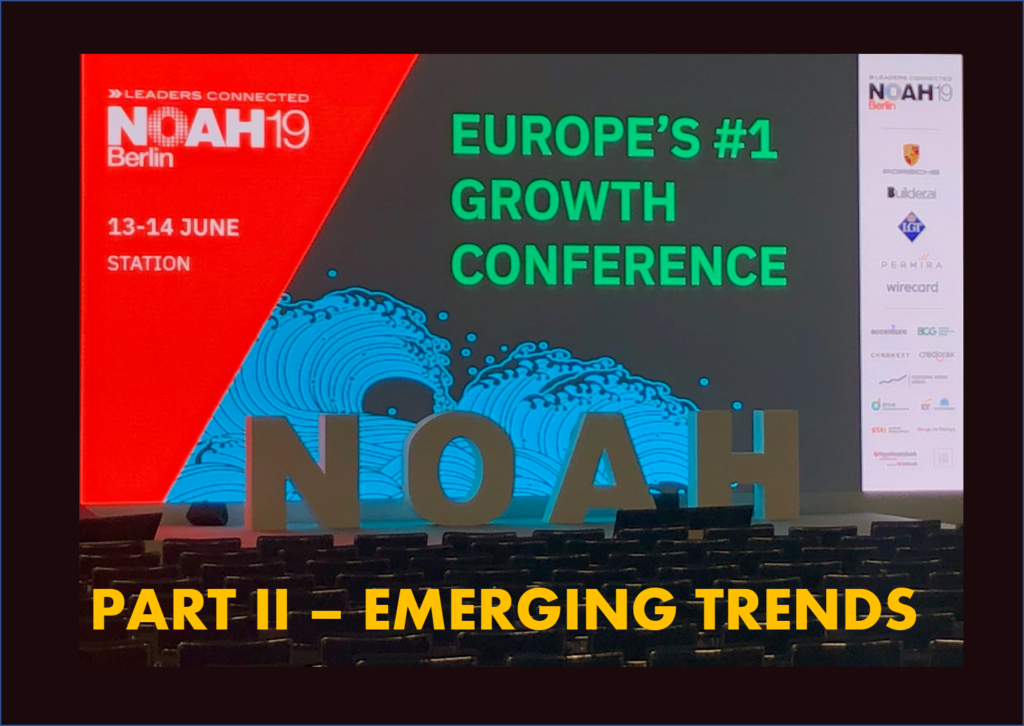
PART II – EMERGING TRENDS
As is common in grandiose conferences, a man has a chance to look beyond the bragging of presenting companies to see also bubbling. To describe in detail all of them would probably be a work competing with the length of Dostoevsky’s Crime and Punishment. Though, I would like to dive us together in detail to at least 4 major trends mentioned:
New types of E-shops and online marketplaces
 If you feel like that there is an e-shop for anything already, ehm, not entirely true. However, the truth is that massive innovations in the E-commerce industry are gradually filling in even the tiny white spots not covered yet. An example of this is CHRONEXT, a second-hand luxury watch market. In addition to the obligatory matching of demand and supply, they have their own workshop with more than 20 watchmakers to ensure authenticity and objectively assess the technical condition of luxury watches. So if a luxury watch owner decides to sell them, (s)he just hands them over to the delivery site (or courier) and the CHRONEXT portal will take care of the certificate of authenticity, fair pricing, sales and delivery to the new owner. Even though for many of us it might be uncommon to use this kind of service, one notable trend is still emerging from this . As the company’s representatives explained in their presentation, the cost of sending a tennis ball and a luxury watch is similar, but their transaction value is disproportionate. Hence, even seemingly “antediluvian” process via post can suddenly create new services in the field of high-value goods. Therefore, it is assumed that marketplaces of such products will be on rise soon. Just be frank to yourself, would you dare to buy “real rolexes” from an Asian-sounding name guy in the past?
If you feel like that there is an e-shop for anything already, ehm, not entirely true. However, the truth is that massive innovations in the E-commerce industry are gradually filling in even the tiny white spots not covered yet. An example of this is CHRONEXT, a second-hand luxury watch market. In addition to the obligatory matching of demand and supply, they have their own workshop with more than 20 watchmakers to ensure authenticity and objectively assess the technical condition of luxury watches. So if a luxury watch owner decides to sell them, (s)he just hands them over to the delivery site (or courier) and the CHRONEXT portal will take care of the certificate of authenticity, fair pricing, sales and delivery to the new owner. Even though for many of us it might be uncommon to use this kind of service, one notable trend is still emerging from this . As the company’s representatives explained in their presentation, the cost of sending a tennis ball and a luxury watch is similar, but their transaction value is disproportionate. Hence, even seemingly “antediluvian” process via post can suddenly create new services in the field of high-value goods. Therefore, it is assumed that marketplaces of such products will be on rise soon. Just be frank to yourself, would you dare to buy “real rolexes” from an Asian-sounding name guy in the past?
Another confirmation of this trend is the StocX, which was created as an e-shop for the sale and purchase of limited series of branded sneakers. (Used ones, of course). In many ways, their processes and procedures match those of Chronext. But they added one more essential ingredient to the pot. Prices were left to decide on prices purely in a similar way as the stock market operates. This, at first glance, insignificant element, has led them to a substantial discovery when introducing their private label products. They published a description of an exclusive limited-edition product and let people specify how much they would be willing to buy the luxury product for. (Originally assumed the price could be about $ 120) When they ranked the bids by offered price, they found that even the 50th highest bid was more than $ 200. Therefore, they decided to sell 50 units at $ 200, which means that 95% of the clients received the product cheaper than originally planned. But they earned almost 70% more than expected, at the same time. Once and again and slowly: you earned 70% more than you planned, and 95% of the clients were surprised by getting it cheaper than they expected. Doesn’t it feel like a business “perpetum mobile” ?
So-called classifiers are a separate line of E-shops development. Although, unfortunately, we do not yet know in Slovakia what classifiers are, in the West several platforms have started war on who will be “Google” in the field of classifiers. Yet these services are very useful and they literally find application in every country. Their essence is – simply put – effective shedding of unnecessary things. As if you crossed-pollinated antique store with a flea market expert and Amazon. One of emerging classifier is Lalafo. In practice, this service works by loading everything you no longer need into a box, a courier (or a robot, but it will come that point later) picking up this box and automatically sort, photo document, describe and publish advertisements of your things, pair the buyers, give them your belongings and send the money to your account (after deducting a small commission). Researches confirm that an ordinary person puts 2 items a year on e-bay or similar portals. The average Lalafo user gives away more than 30 of them. Thus, classifiers can significantly save the planet when they find yet another use for things that would otherwise end up in waste bin. As this twangs on the sensitive strings of the current society, it is clear that the classifiers are on a path for a rocket launch.
By the way, the Lalafo presentation was unique in yet another way. Lalafo officials brought a mock-up of a sorting robot to the podium, which presented part of the presentation in the synthesized human voice. In addition to the thunderous applause in the hall, it was the first powerpoint presentation in my life that have been delivered (at least partially) by the robot.
Online food market
Interesting things are happening on the food market as well. Especially in larger cities, the market for food delivery directly via applications like Lieferando or DeliveryHero has already heated up. Here in Berlin it is almost impossible to cross the street in the evening without encountering a delivery man with a meal package. As some traditional restaurants are busy enough anyway, and yet others hesitate to get involved in the delivery cycle, the demand for online food has grown much faster than the supply did. Big players, like above mentioned DeliveryHero, had to start opening restaurants that cook for them exclusively. To have something to deliver first place. This gave rise to the concepts of so-called cloud kitchens (a location with a fully equipped and staffed kitchen at a strategic transport hub ready to open brand new branch of your great restaurant chain) or ghost kitchens (kitchens that have a strong brand but only cook exclusively for delivery app, having no tables and no where to try beyond the bare delivery).
Delivery services quickly realized that their business depended on how they could stimulate the growth of cooked and order food through their portal. Therefore, almost over-the-night they have become B2B partners, who finance the opening of new restaurants, advise on marketing and expanding operations, or collect suggestions from end consumers for new recipes and meals.
However, the online food market has one more interesting branch, the so-called boxed food line, represented mainly by companies like MarleySpoon. Unlike boxes with ready-to-eat, which  you had a chance to meet in various EU regions (especially as the weight loss methods), the mission of modern boxes is to supply all the ingredients and recipe so that people can cook their own food. This approach also carries with so-called the IKEA effect, where you have a different emotional relationship to the cabinet that you put together with your own hands than the furniture you bought as a whole. MarleySpoon, nonetheless, has another important mission in mind. They recycle their (cooling) boxes. This move not only stimulates re-purchase (what you will do with empty boxes?), but also promotes the environment. That is also (one of) the reason(s) why they do not rush to sell through most of supermarkets, but only cooperate with Fresh-Markets (they do not wish to leave the boxes on the shelf of the store for a few days or throw away those not sold during their shelf-lifespan).
you had a chance to meet in various EU regions (especially as the weight loss methods), the mission of modern boxes is to supply all the ingredients and recipe so that people can cook their own food. This approach also carries with so-called the IKEA effect, where you have a different emotional relationship to the cabinet that you put together with your own hands than the furniture you bought as a whole. MarleySpoon, nonetheless, has another important mission in mind. They recycle their (cooling) boxes. This move not only stimulates re-purchase (what you will do with empty boxes?), but also promotes the environment. That is also (one of) the reason(s) why they do not rush to sell through most of supermarkets, but only cooperate with Fresh-Markets (they do not wish to leave the boxes on the shelf of the store for a few days or throw away those not sold during their shelf-lifespan).
Whether you want to cook or you want to come to “ready-to-eat” meal, online services are likely soon to take on a relatively large share of the food we eat at home with our family. Thus there is a clear revolution in the diet unwinding, which (a little surprisingly) is not one of the extremes of the “going to the restaurant”, “making a big shopping and cooking at home” spectrum. This introduces another hard and very significant trend. Both of the above mentioned issues will be a negative hit on conventional grocery supermarkets. In either of the ways, the customer does not buy groceries from chain store any more. It is unclear if supermarkets are aware of this down to this depth, but they are anyway trying to respond to craving of online food purchases. To be honest, I have to admit that the DeliveryHero presentation has also teased up a whole new perspective on the issue. Think buying food online: What do you consider to be more difficult: Supply the food items stipulated in the order OR ensure timely and very cheap delivery to your home? Do you also see that if any of those 2 activities turns into commodity and the other is an act of art, it will be the food itself ending up as commodity. Thus, if a delivery companies compete with an excellent foreign food delivery player AGAINST grocery chain with its own food chain , who would you bet on in the long run? Companies mastering efficient food delivery networks in cities will be able to attack the grocery purchases in online assault. You can probably smell already the consequences of such a change. So far, subtly, but along time passing, it bubbles and becomes burning pathway for general chain stores.
Future direction(s) of digital services and markets
A lecture by FJ Labs, presented by none other than the legendary Fabrice Grinda, would most likely deserve a separate blog. It is one of those lectures where you do not know if you should take pictures of slides, write notes from things that the speaker said beyond the slides, or start thinking about how that impacts you. FJ Labs specialize in starting and investing in E-shops and online services. They set up or purchase annually more than 350 of them, with none of the transactions below level of tens of millions of dollars. Furthermore, they advise more than 1,000 projects a year that they had not managed to invest into. If you’re looking for someone who really understands the online service most thoroughly in the world, you may have just found him.
Their presentation initially named the factors that over and over again relentlessly separate the grain from the chaff, successful E-commerce projects from the start-ups that simply blew up. Since these topics are not necessarily the daily bread of themightydata.com audiences, I will try to depict in detail rather the second part of the presentation, which introduced what new areas of digital services are just hatching out. The first clearly documented trend was the verticalization of established services. Just as Grindr was a specific offshoot of Tinder‘s “dating service,” specific segments of demand of large services such as Uber Eats, ebay or UpWork are also being gradually cut off newcomers. And this trend does not shy away even from such Titans as AirBnB (from which the Luxury Retreats steal the base).
The second major trend is the expansion of B2B markets. Unlike end-user portals, B2B marketplaces offer not only more valuable shopping carts, a higher margin, but also a higher likelihood of re-purchase (the company buys things for its operation that is continuous). Examples are portals such as RIG UP, knowde or FLEXPORT.
The 3rd important trend is that successful online services are increasingly focusing on the OFF-premise model, i.e. operating without physical operations (and assets). Examples include not only the above-mentioned ghost kitchens, but also travel services and legal services such as AirHelp.
Another emerging trend is that while marketplaces were bilateral in the first wave of portals, they are operating rather unilaterally today. In the past, both the demand side and the supply side had to reconcile each other before the service or goods were launched. Moreover, matching and quality management were purely market mechanisms. Modern online markets are moving to a model where the client expresses their preference and the portal chooses for him/her, confirms the transaction and starts service implementation directly. (Remember the Outfittery from Part 1 of our NOAH series) IN long term, this indicates a greater need for AI and a worse negotiating position for the supply side.
No less fascinating was hearing from Fabric Grinda’s mouth (and slides) where our journey of online services was heading. Based on the data available to them, he predicted a sharp increase in areas such as digitization of real estate sales and further fragmentation of financial services through Lending clubs (i.e. peer-to-peer loans directly between people without the presence of banks). Strong changes are also awaiting us in the digitization of the labor markets, both in the search for a full-FTE job as well as in the development of micro-work assignments (a form that we would label as a free-lance today). Just as some people got their second job in the evening thanks to Uber, other micro-services will come to turn individuals’ free time into an additional income. This trend is directly related to another growth impulse, this time for EduTech (which we will address directly in the last chapter of this blog.) The last area, where FJ Labs is expecting significant changes, is the automotive sector, which will be hit not only by car-sharing services, by car-pooling and other forms of mobility (e.g. air transport), but also change of guard in the most dominant car sales channel. (Anybody e-shops?)
Quo vadis Transport?
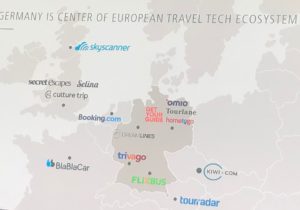 Perhaps less noticeable, but equally interesting, was the presentation of the French company Bla-Bla-Car whose mission could be called guaranteed hitch-hiking. They have built a carpooling portal that connects car drivers who want to share the ride with “hitch-hikers” willing in return to contribute to the gasoline costs of driver. And managed they did really a large scale of that mission. Their service had already provided passenger transport over 22 billion kilometers. As the service fills with passengers the cars that would drive their route anyway, they save 1.6 million tons of carbon dioxide annually. Nevertheless, the presentation of Bla-bla car was interesting for another reason. They decided to announce the launch of the new Bla-Bla-Bus service, which introduces a bus version of service. Of course, buses do not just wander around the country and do not take random hitch-hikers, the service literally creates regular bus lines. However, it will deliver 3 essential differences compared to traditional bus carriers. The first major distinction is that Bla-Bla-Bus will not own its buses, but will be a kind of UBER for bus service. Thus It is a direct competitor of the German FlixBus, which already successfully operates this model throughout Europe, including CEE. Individual bus owners can subscribe to Bla-Bla-Bus on a voluntary basis, giving the platform a chance to acquire a much larger fleet (in much shorter time) than if relying on sourcing of its own vehicles. The second major distinction of Bla-Bla-Bus (which also gives it a competitive edge over the FlixBus), is the fact that it uses data from the Bla-Bla-Car transport history. This way the service knows how many people need to move from where to where at what time. As illustrated on example of France, their home country and the strongest market, there are 200 large bus stations for important intercity lines in France, but their Bla-Bla-car users have used 250,000 different pickup points. This enables company to plan routes with unconventional stops (where normal buses would not stop) in areas with a huge demand to get into (or out of) the car. The third essential factor of the distinction is fact that all bla-bla-buses automatically report their location. Thus, from the customer’s point of view, one gets again similar information comfort as with Uber. You can see exactly where your bus is, whether it’s on time, and if your partner or family should be ready to pick you up when you get off the bus.
Perhaps less noticeable, but equally interesting, was the presentation of the French company Bla-Bla-Car whose mission could be called guaranteed hitch-hiking. They have built a carpooling portal that connects car drivers who want to share the ride with “hitch-hikers” willing in return to contribute to the gasoline costs of driver. And managed they did really a large scale of that mission. Their service had already provided passenger transport over 22 billion kilometers. As the service fills with passengers the cars that would drive their route anyway, they save 1.6 million tons of carbon dioxide annually. Nevertheless, the presentation of Bla-bla car was interesting for another reason. They decided to announce the launch of the new Bla-Bla-Bus service, which introduces a bus version of service. Of course, buses do not just wander around the country and do not take random hitch-hikers, the service literally creates regular bus lines. However, it will deliver 3 essential differences compared to traditional bus carriers. The first major distinction is that Bla-Bla-Bus will not own its buses, but will be a kind of UBER for bus service. Thus It is a direct competitor of the German FlixBus, which already successfully operates this model throughout Europe, including CEE. Individual bus owners can subscribe to Bla-Bla-Bus on a voluntary basis, giving the platform a chance to acquire a much larger fleet (in much shorter time) than if relying on sourcing of its own vehicles. The second major distinction of Bla-Bla-Bus (which also gives it a competitive edge over the FlixBus), is the fact that it uses data from the Bla-Bla-Car transport history. This way the service knows how many people need to move from where to where at what time. As illustrated on example of France, their home country and the strongest market, there are 200 large bus stations for important intercity lines in France, but their Bla-Bla-car users have used 250,000 different pickup points. This enables company to plan routes with unconventional stops (where normal buses would not stop) in areas with a huge demand to get into (or out of) the car. The third essential factor of the distinction is fact that all bla-bla-buses automatically report their location. Thus, from the customer’s point of view, one gets again similar information comfort as with Uber. You can see exactly where your bus is, whether it’s on time, and if your partner or family should be ready to pick you up when you get off the bus.
The presentation of LakeStar, respected Venture Capital (also behind Spotify, AirBnB or Skypom), confirmed that although Silicon Valley dominates many digital services, but Germany 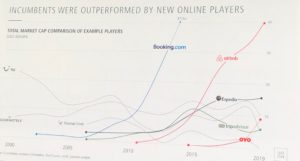 and its neighboring countries are very strong in transport start-ups. Of the top 20 such services in the EU, up to 11 of them come from this region. And full 7 of them operate precisely from Germany. (see slide) Another interesting piece of knowledge is the digitization is likely to finally push the last nail into the coffin for travel agencies. By comparison, the value of TUI (probably Europe’s largest travel company) dropped from $ 24 billion in 2000 to barely $ 6 billion today, while booking.com has risen from zero to $ 71 billion over the same period. Even in less than half of the same time window, AirBnb grew from zero to 40 billion. This brings us to the 4 trends Lakestar foresees for the industry to unveil soon:
and its neighboring countries are very strong in transport start-ups. Of the top 20 such services in the EU, up to 11 of them come from this region. And full 7 of them operate precisely from Germany. (see slide) Another interesting piece of knowledge is the digitization is likely to finally push the last nail into the coffin for travel agencies. By comparison, the value of TUI (probably Europe’s largest travel company) dropped from $ 24 billion in 2000 to barely $ 6 billion today, while booking.com has risen from zero to $ 71 billion over the same period. Even in less than half of the same time window, AirBnb grew from zero to 40 billion. This brings us to the 4 trends Lakestar foresees for the industry to unveil soon:
a] Travelers are increasingly looking for branded offerings that are not a cocktail of no-name providers, but rather a comprehensive experience like service of GetYourGuide.
b] Most likely already in forthcoming year, the value of accommodation rental portals (like Airbnb) will exceed the value of all hotel chains. The hotels officially become only Plan B, unless you happen to get accommodation differently.
c] dthe market of so-called Smart Travel Advisors is also developing dynamically; Customized experiences that you can take part in mainly thanks to local enthusiasts and (orchestration) of tiny service providers.
d] apparently under the pressure of ever-accelerating life pace, the demand for holiday packages, such as sightseeing round trips or thematic tours, is surprisingly booming. However, unlike in the past, these tours are not compiled by travelers on their own, but users are expect them to be intelligent ensemble (and suggestion) of accommodation booking portals from the “components they have in inventory”.
If you thought everything had been already digitized in travel and transport, presentations by Zizoo, Campenda and Sailogy would correct your view. While digital services already dominate the classic search for accommodation, airline tickets or buses, there are still sectors that are only at the beginning of this digitization movement (and therefore are only experiencing their boom right now). Probably the most prominent representatives of this second wave are the services that offer the rental of small cruise ships and caravans. Few of us have the opportunity to own our own motorboat, small sailing boat or comfortably furnished caravan. Therefore, if you long for this kind of rest, you have in the past been reliant on renting such a boat or caravan from small, local owners or few-pieces providers. The above named services in this paragraph, in matter-of-fact, gradually create a kind of booking.com solely for these types of holidays. A yacht cruise is no longer just a fancy treat, as you can order a boat with a captain and food from the warmth of your living room, at any seaside location, on your chosen days, for a price as low as 50 EUR per person and a day. The skyrocketing number of orders from these portals prove that cruises will probably be a hit in the nearest tourist seasons to come.
EduTech = education in completely different way
A separate section within the NOAH conference was also carved out for the EduTech industry; in other words, digital services in education. At first glance, again a topic that we do not read from the front pages of our newspapers and magazines in CEE, but which is experiencing a massive boom in developed markets. If you are in the field of data analysis, you have certainly noticed the boom of portals such as Coursera or Udemy, which allow you to learn specific skills.
However, in addition to these trends, relatively less conspicuous services are coming to the forefront, starting to compete with traditional education in various forms and shapes. You live in a small town or village and you like the group-based language study model? But in the surrounding area happens to be no language school that opened course for the language of your choice? Do you want to spare yourself from commute several times a week to the nearest regional city for that matter only? Well, then Lingoda, which provides online group language courses, can be a solution for you. You have your permanent group and you can join from anywhere around the globe. Even from a business trip or from a vacation (if you really prefer so first place).
Are you planning to take a bold step in your business that you are not sure if has been tried by someone else before? Don’t you just want to learn from your own mistakes? Thus, try using the ReserachGate portal, which is unique in a sense that it brings together the results of experiments and first attempts at breakthroughs, no matter how (bad) they turned out. Unlike conventional “scientific” portals, where you will find only boasted successes (and discrete silence about mis-hap’s), on ReserachGate you can also view failures and projects that worked quite differently than originally intended. You can save not only a lot of funds but also some of a professional shame.
Do you have a child for whom school is going smoothly? Or on the contrary, would your child benefit from a little help of his/her peers? Then check out Brainly portal, which brings together students who help other peers to swallow their curriculum. This viral growth trend offers more than a “template paper” (or exercises) from which you can “inspire” for completing your ones. You will find a person from flesh-and-bones who had passed the course more smoothly and can give you a explanation closer to you than that of your real teacher. In addition, if you were absent or ill, you do not have to rely solely on the notes of your classmates; you can have the substance fully explained by someone who has already understood it. Whenever it suits you.
More and more online educational portals are applying for official accreditation to offer their students full academic degrees on course(s) completion. At a point when there is a desperate demand for certain professions (like Data Analysts), portals like OpenClassRooms can go extra mile and guarantee their students employment after graduation from the course. They aggregate companies’ desperate demand and, as being able to guarantee strict training quality standard, they are able to place their entire ‘class’ into specific job offers. Hungry firms even agree to refund part of student tuition fees of newly trained employees, so it’s literally a win-win-win model.
>>> continue READING HERE
You have just read the second part of the inspiration from NOAH 2019 conference. You can read more fascinating information from this conference in the first or third part of this mini series.
 reaches 8.5 million of players from all around the Globe. As it is a multi-player game, its creators (EpicGames studio) must carefully store what each player has done, as the interactions of the players are what determines if your character has survived or you are dead (and hence out of the game). In Fortnite (under the guise of the incoming cataclysmic storm), the game space is constantly shrinking, inevitably leading to clashes of the individual characters (of players), confirming that Darwin was not mistaken, after all.
reaches 8.5 million of players from all around the Globe. As it is a multi-player game, its creators (EpicGames studio) must carefully store what each player has done, as the interactions of the players are what determines if your character has survived or you are dead (and hence out of the game). In Fortnite (under the guise of the incoming cataclysmic storm), the game space is constantly shrinking, inevitably leading to clashes of the individual characters (of players), confirming that Darwin was not mistaken, after all. But this rosy it looks only if you are the business owner. A less optimistic shade surfaces for you if you are a developer charged with task to program the very game. According to the data published at the conference NOAH LONDON 2019, huge demans of players of new Andry Birds Dream Blast game requires that the company has to create 40 brand new game levels each week. If you don’t scowl on the this tempo yet, I’ll try to put it into context: The average working week is 5 x 8 = 40 working hours. Hence, the developers team of this game must devise, program, test and deploy a new level every working hour. Every single one! Surely, you can have an army of programmers working in parallel to catch up and program a new level of play in below hour. But how can you thoroughly test a game level within a given hour interval when a single run of play may require a few minutes itself? Even with battalion of 100 testers, after the development of the level itself, they would be able to play it in remaining time of hour perhaps 500-600 times at max. And that is too little for company to understand how millions of different users will rate the game. So the role of data comes in here again.
But this rosy it looks only if you are the business owner. A less optimistic shade surfaces for you if you are a developer charged with task to program the very game. According to the data published at the conference NOAH LONDON 2019, huge demans of players of new Andry Birds Dream Blast game requires that the company has to create 40 brand new game levels each week. If you don’t scowl on the this tempo yet, I’ll try to put it into context: The average working week is 5 x 8 = 40 working hours. Hence, the developers team of this game must devise, program, test and deploy a new level every working hour. Every single one! Surely, you can have an army of programmers working in parallel to catch up and program a new level of play in below hour. But how can you thoroughly test a game level within a given hour interval when a single run of play may require a few minutes itself? Even with battalion of 100 testers, after the development of the level itself, they would be able to play it in remaining time of hour perhaps 500-600 times at max. And that is too little for company to understand how millions of different users will rate the game. So the role of data comes in here again. And so the prisons came to focus as well. The Artificial Intelligence Instruction Program, developed by the University of Helsinki, has become an official re-qualification program for prisoners since May 2019 to improve their labor market chances after end of their sentence. Prison in Turku, south of Finland, has indeed purchased computers and tablets from a government grant and real AI lessons have been already launched in there. That it is not a pseudo (or pretended) attempt is confirmed by the fact that for AI course exercises the prison had to allow access (white-list) set of websites from which the course grabs needed data sets. Completion of the course ends with an official certificate for inmate. The University of Helsinki even committed to grant convicts credits for the passed courses, so that they can study the full science degree after being released from the prison. The program, running in Turku since May 2019, will be now extended to 3 more prisons in the country as of this month.
And so the prisons came to focus as well. The Artificial Intelligence Instruction Program, developed by the University of Helsinki, has become an official re-qualification program for prisoners since May 2019 to improve their labor market chances after end of their sentence. Prison in Turku, south of Finland, has indeed purchased computers and tablets from a government grant and real AI lessons have been already launched in there. That it is not a pseudo (or pretended) attempt is confirmed by the fact that for AI course exercises the prison had to allow access (white-list) set of websites from which the course grabs needed data sets. Completion of the course ends with an official certificate for inmate. The University of Helsinki even committed to grant convicts credits for the passed courses, so that they can study the full science degree after being released from the prison. The program, running in Turku since May 2019, will be now extended to 3 more prisons in the country as of this month. Some are more original and aggressive (like Finland), some countries are content only to copy the US, China or Japan. Slovakia is now also in this creation process and since I am honored to be part of it, here you can read
Some are more original and aggressive (like Finland), some countries are content only to copy the US, China or Japan. Slovakia is now also in this creation process and since I am honored to be part of it, here you can read 
 The invention of a gramophone (and soundtrack recording) had brought a fundamental revolution in music units. Music suddenly stopped being sold in experience units (which will have its historical implications, but we will revisit it later), but the the music medium has become the unit of music. Firstly (gramophone) vinyls, then magnetic tapes and CD’s ultimately. Since most of us were born already into this set-up, we don’t find it strange. However, when you get a little historic zoom-out, you may realize that selling music by a “medium unit” is like selling sausages by area of the packaging or health by number of blood cans. On other words, it is not important how much benefit you buy in the package, literally, only the size of the package matters.
The invention of a gramophone (and soundtrack recording) had brought a fundamental revolution in music units. Music suddenly stopped being sold in experience units (which will have its historical implications, but we will revisit it later), but the the music medium has become the unit of music. Firstly (gramophone) vinyls, then magnetic tapes and CD’s ultimately. Since most of us were born already into this set-up, we don’t find it strange. However, when you get a little historic zoom-out, you may realize that selling music by a “medium unit” is like selling sausages by area of the packaging or health by number of blood cans. On other words, it is not important how much benefit you buy in the package, literally, only the size of the package matters. The figurative last nail into Album’s coffin was an apple. In order to re-balance a reputation from the gravitational law (when fame was treacherously attributed entirely to Newton, and the apple got out of it with mere proverb “didn’t fall far from the tree.”) Taught by this crisis, this time the apple left nothing to chance and under its English pseudonym “Apple Inc.” brought the World the iTunes application. (which broke the album metric system for good). In Apple products, the music was suddenly available, God help us, by pieces. The world order has turned again from the head to its feet and you could buy (in the sense of the above analogy) sausages by pieces rather than by package loads.
The figurative last nail into Album’s coffin was an apple. In order to re-balance a reputation from the gravitational law (when fame was treacherously attributed entirely to Newton, and the apple got out of it with mere proverb “didn’t fall far from the tree.”) Taught by this crisis, this time the apple left nothing to chance and under its English pseudonym “Apple Inc.” brought the World the iTunes application. (which broke the album metric system for good). In Apple products, the music was suddenly available, God help us, by pieces. The world order has turned again from the head to its feet and you could buy (in the sense of the above analogy) sausages by pieces rather than by package loads.
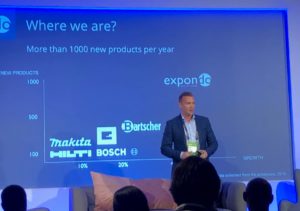 Expondo
Expondo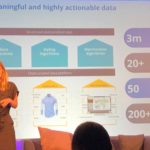 underlying data analytics engines are so well-tuned that from over 1 million clients portfolio, incredible 40% of customers are so satisfied with what Outfitters have recommended to them that they choose to activate subscription. This works by sending items on a monthly basis that they have never seen before nor indicated any preference for them, yet they like them so much that they keep them. Clients have literally outsourced their wardrobe to the e-shop. And all this is happening in so taste sensitive and demanding industry as fashion is.
underlying data analytics engines are so well-tuned that from over 1 million clients portfolio, incredible 40% of customers are so satisfied with what Outfitters have recommended to them that they choose to activate subscription. This works by sending items on a monthly basis that they have never seen before nor indicated any preference for them, yet they like them so much that they keep them. Clients have literally outsourced their wardrobe to the e-shop. And all this is happening in so taste sensitive and demanding industry as fashion is. The industry, which has long been stumbling somewhere on the interface between small e-shops and (even smaller) off-line stores, is selling nutritional supplements (especially for bodybuilding or fitness). The Supplementer.com portal is a very interesting way of simultaneous (and synergistic) activity both in on-line and off-line; In addition to the private label, which is common in the industry and in CEE it is smartly operated by
The industry, which has long been stumbling somewhere on the interface between small e-shops and (even smaller) off-line stores, is selling nutritional supplements (especially for bodybuilding or fitness). The Supplementer.com portal is a very interesting way of simultaneous (and synergistic) activity both in on-line and off-line; In addition to the private label, which is common in the industry and in CEE it is smartly operated by  human movement. However, with the advent of new trends in mobility, these data points are taking on completely new fields of application. A much larger sibling of Instarea, the
human movement. However, with the advent of new trends in mobility, these data points are taking on completely new fields of application. A much larger sibling of Instarea, the 
 If you feel like that there is an e-shop for anything already, ehm, not entirely true. However, the truth is that massive innovations in the E-commerce industry are gradually filling in even the tiny white spots not covered yet. An example of this is
If you feel like that there is an e-shop for anything already, ehm, not entirely true. However, the truth is that massive innovations in the E-commerce industry are gradually filling in even the tiny white spots not covered yet. An example of this is  you had a chance to meet in various EU regions (especially as the weight loss methods), the mission of modern boxes is to supply all the ingredients and recipe so that people can cook their own food. This approach also carries with so-called the IKEA effect, where you have a different emotional relationship to the cabinet that you put together with your own hands than the furniture you bought as a whole. MarleySpoon, nonetheless, has another important mission in mind. They recycle their (cooling) boxes. This move not only stimulates re-purchase (what you will do with empty boxes?), but also promotes the environment. That is also (one of) the reason(s) why they do not rush to sell through most of supermarkets, but only cooperate with Fresh-Markets (they do not wish to leave the boxes on the shelf of the store for a few days or throw away those not sold during their shelf-lifespan).
you had a chance to meet in various EU regions (especially as the weight loss methods), the mission of modern boxes is to supply all the ingredients and recipe so that people can cook their own food. This approach also carries with so-called the IKEA effect, where you have a different emotional relationship to the cabinet that you put together with your own hands than the furniture you bought as a whole. MarleySpoon, nonetheless, has another important mission in mind. They recycle their (cooling) boxes. This move not only stimulates re-purchase (what you will do with empty boxes?), but also promotes the environment. That is also (one of) the reason(s) why they do not rush to sell through most of supermarkets, but only cooperate with Fresh-Markets (they do not wish to leave the boxes on the shelf of the store for a few days or throw away those not sold during their shelf-lifespan). Perhaps less noticeable, but equally interesting, was the presentation of the French company
Perhaps less noticeable, but equally interesting, was the presentation of the French company  and its neighboring countries are very strong in transport start-ups. Of the top 20 such services in the EU, up to 11 of them come from this region. And full 7 of them operate precisely from Germany. (see slide) Another interesting piece of knowledge is the digitization is likely to finally push the last nail into the coffin for travel agencies. By comparison, the value of TUI (probably Europe’s largest travel company) dropped from $ 24 billion in 2000 to barely $ 6 billion today, while booking.com has risen from zero to $ 71 billion over the same period. Even in less than half of the same time window, AirBnb grew from zero to 40 billion. This brings us to the
and its neighboring countries are very strong in transport start-ups. Of the top 20 such services in the EU, up to 11 of them come from this region. And full 7 of them operate precisely from Germany. (see slide) Another interesting piece of knowledge is the digitization is likely to finally push the last nail into the coffin for travel agencies. By comparison, the value of TUI (probably Europe’s largest travel company) dropped from $ 24 billion in 2000 to barely $ 6 billion today, while booking.com has risen from zero to $ 71 billion over the same period. Even in less than half of the same time window, AirBnb grew from zero to 40 billion. This brings us to the